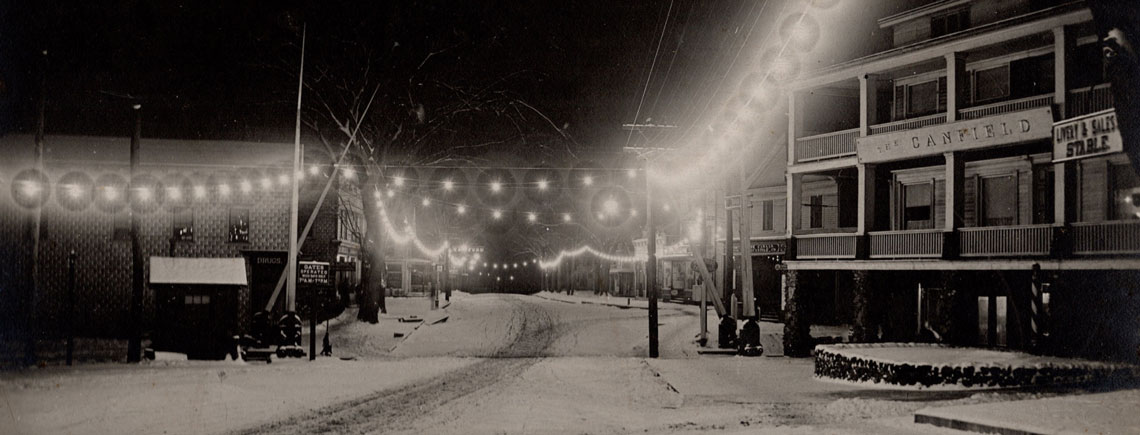Canaanites Rejoice
Canaan Embraces Season of Light
My hometown has outdone itself this year. With a handful of new businesses in town whose owners have fresh ideas and considerable energy, the town is pulling itself out of the Covid doldrums.
It visibly displayed this new pride Thanksgiving weekend when the town ushered in the Season of Lights with a fine display of Christmas decorations and a walkway lined with luminarias. Through these alleys of illumination, a parade of lights—vehicles ablaze with holiday lights and carrying whimsical Christmas characters—processed through town to the delight of a large crowd of observers.
It was not exactly Macy’s Thanksgiving Parade but it lit up social media in the days following the event and focused attention on a community on the rebound. Even my family got into the act with a little video circulating of my great-nephew passionately trying to intervene as a cop handcuffed the “Grinch who Stole Christmas.” “It is my auntie!” he anxiously explained to the officer.
Canaan has a long history of celebrating Christmas with lights. Electricity came early to the town thanks to the foresight of businessmen as energetic and motivated as the current cluster of entrepreneurs. By 1902, the village streets had moved past the kerosene lamps of old and were lit by electric bulbs. Stores and homes could switch on lights in late afternoon and brighten their surroundings until midnight. In the morning the power plant was started at 5AM in winter and shut down again after daylight.
Five bulbs in a home (in the earliest days one bulb per room would have been typical), each providing 16 candlepower, would cost 84 cents for six hours—a considerable luxury equivalent to about $25 today. No wonder there were only five customers in East Canaan.
But electricity had come to stay and by 1905 Canaan’s J. Henry Roraback, “boss” of the Connecticut Republican Party and an economic mover and shaker, embraced electricity’s future. He consolidated the little companies providing power to area towns and formed the Berkshire Power Company. In 1905, he received a charter for the Rocky River Power Company to develop hydro power on the Housatonic River and by 1917 his company morphed into the Connecticut Light and Power Company. Suddenly the Northwest Corner was “ablaze” with light. A 1913 image shows strands of wire strung along Canaan’s Main Street, punctuated with bulbs that illuminated a snowy scene.
It did not take long before someone decided to use the lights to add Christmas cheer. My mother, born in 1922, had among her earliest memories a night she rode downtown in a sleigh. Someone had taken a string of the clear light bulbs and individually painted them in red, blue and green. She declared it to be the most beautiful sight her young eyes had yet beheld.
Fast forward 30 years to an evening when my parents walked with me up Main Street in the aftermath of a Christmas storm. On that snowy evening strings of lights in red, green and blue glowed through the snow that capped shrubs along the street. Strands of lights crisscrossed the snow-covered road and, like my mother before me, I was enchanted.
By then, we were in the Golden Age of Christmas, the 1950s, when the holiday had taken on all the homely features that we cherish today. The Puritan distain for the holiday had softened, St. Nick had taken on his rosy-cheeked, rotund persona and Christmas trees were in virtually every American parlor.
Trees were much later additions to the holiday than modern Americans might realize. They were dangerous things in my mother’s youth and the real candles clipped to the ends of branches were only briefly lighted on Christmas Eve for fear of burning down the house.
The concept of electric tree lights was already known—indeed, only two years after Thomas Edison perfected the incandescent light bulb in 1880, his close friend, Edward H. Johnson, showed off a tree decorated with 126 light bulbs. It was such a wonder it received press coverage in several prestigious publications but was not enough to launch a craze. The cost of a string of lights—some $80 in modern dollars—and the fact they had to be installed by electricians put a damper on their use by any but the wealthy.
But as people became more attuned to household electricity, strings of electric bulbs became increasingly common on Christmas trees. Companies, including most notably General Electric, entered the Christmas light business and by the 1930s electric Christmas lights had become a standard part of holiday decorating.
Today, with houses awash with light inside and out, the nation’s energy consumption increases by 30 percent during the Christmas season. In the U.S. Christmas decorations account for 6.63 billion kilowatt-hours of electricity consumption.
The modest Christmas tree, once adorned with kernels of popcorn strung on thread and paper ornaments, has become a thing of wonder. Over the years, the trees have been decorated in an endless array of lights: white, colored, big, small, twinkling and steady. Early lights were usually white but were replaced for a few decades by colored versions (perhaps as a better accent for the aluminum trees of the 1950s and ’60s). The 1980s brought a resurgence of white lights and a continuing debate between aficionados of the differing styles.
Happily, it is a debate that does not need to be won; there is surely room for both. So this Christmas let your little light shine, beaming forth their message of goodwill to all. But spare a thought for the environment and switch them off from time to time.

